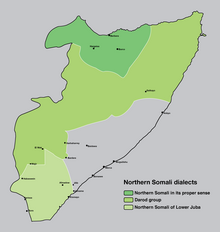Northern Somali
| Northern Somali | |
|---|---|
| Af Waqooyi — Maxaa Tiri | |
| Native to | Somalia, Somaliland, Djibouti, Ethiopia |
Afro-Asiatic
| |
| Language codes | |
| ISO 639-3 | – |
| Glottolog | nort3051 |
Northern Somali (Somali: Af Waqooyi),[1] (alternatively known as Maxaa Tiri),[2] is a dialect of the Somali language and forms the basis for Standard Somali.[3][4] It is spoken by more than 70% of the entire Somali population, with its speech area stretching from Djibouti, Somaliland and the Somali Region of Ethiopia to the Northern Frontier District in Kenya.[5] This widespread modern distribution is a result of a long series of southward population movements over the past ten centuries from the Gulf of Aden littoral.[6]
Overview
[edit]
Northern Somali is spoken by more than 70% of the entire Somali population.[7] Its primary speech area stretches from Djibouti, Somaliland and to parts of the eastern and southwestern sections of Somalia.[8] This widespread modern distribution is a result of a long series of southward population movements over the past ten centuries from the Gulf of Aden littoral.[9]
Northern Somali is subdivided into three dialects: Northern Somali proper (spoken in the northwest), the Darod group (spoken in the northeast and along the eastern Ethiopia frontier), and the Lower Juba group (spoken by northern Somali settlers in the southern riverine areas).[7] Northern Somali has frequently been used by famous Somali poets as well as the political elite, and thus has the most prestige out of the Somali dialects.[10] Due to being wide spread, it forms the basis for Standard Somali.[11] Most of the classical Somali poetry is recited and composed in the Northern Somali dialect.[7] The dialect of the Isaaq clan-family has the highest prestige of any other Somali dialect.[12]
Northern Somali also contains many Harari loanwords.[13]
Varieties
[edit]Lamberti divides Northern Somali into three subgroups:[14]
- Northern Somali proper: spoken in the countries of Djibouti and Somaliland (Awdal, Maroodi Jeex, Saaxil, Togdheer, Sanaag and Sool). The dialects belonging to this group are the Issa, Gadabuursi, Isaaq and the northern Darod (Warsangeli and Dulbahante). The greatest number of speakers overall.
- Darod group: spoken in the regions of Bari, Nugal, Mudug, in the Somali Region of Ethiopia and along the Ethiopian border in the regions of Galguduud, Bakool and Gedo. The dialects of this group are the North-Eastern dialects (Majeerteen, Marehan and Ogaden).
- Lower Juba group: spoken by the part of the Northern Somali population which have immigrated into the Lower Juba region in the last 100/150 years. As this territory was a Benaadir-speaking area before the arrival of the immigrants from the north, the Nsom of Lower Jubba presents many peculiarities typical for the Benaadir dialects and could be considered a Benaadirised Nsom.
References
[edit]- ^ Lamberti, Marcello (1986). Map of Somali dialects in the Somalia Democratic Republic (PDF). H. Buske. ISBN 9783871186905.
- ^ Studies, European Association of Somali; Association, Somali Studies International (2001). Variations on the Theme of Somaliness: Proceedings of the EASS/SSIA International Congress of Somali Studies, Turku, Finland, August 6-9, 1998. Centre for Continuing Education, Åbo akademi University. p. 229. ISBN 978-952-12-0823-2.
- ^ Dalby, Andrew (1998). Dictionary of languages: the definitive reference to more than 400 languages. Columbia University Press. p. 571.
- ^ "Somali Language - Structure, Writing & Alphabet - MustGo". MustGo.com. Retrieved 2021-04-25.
- ^ Mundus, Volumes 23-24. Wissenschaftliche Verlagsgesellschaft. 1987. p. 205.
- ^ Andrzejewski & Lewis (1964:6)
- ^ a b c Lamberti, Marcello (1986). Map of Somali dialects in the Somali Democratic Republic (PDF). H. Buske. ISBN 9783871186905.
- ^ Mundus, Volumes 23-24. Wissenschaftliche Verlagsgesellschaft. 1987. p. 205.
- ^ Andrzejewski, B.; Lewis, I. (1964). Somali poetry: an introduction. Clarendon Press. p. 6.
- ^ Saeed, John (1999). Somali. Amsterdam: John Benjamins. p. 5. ISBN 1-55619-224-X.
- ^ Ammon, Ulrich (2006). Sociolinguistics: An International Handbook of the Science of Language and Society, Part 3. Walter de Gruyter. p. 194. ISBN 9783110184181.
- ^ Pia, John Joseph (1968). Somali Sounds and Inflections. Indiana University. p. 6.
- ^ Lafkioui, Mena (2013-04-30). African Arabic: Approaches to Dialectology. Walter de Gruyter. p. 5. ISBN 978-3110292343.
- ^ Blench, Roger (2006). "The Afro-Asiatic Languages: Classification and Reference List" (PDF). p. 3.
